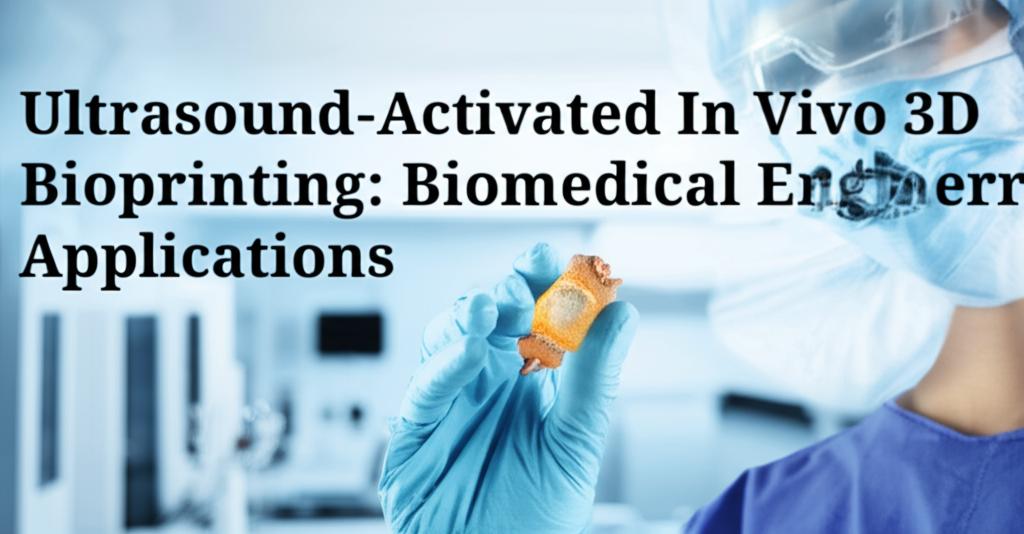A new era in medical treatment is dawning with the advent of ultrasound-activated in vivo 3D bioprinting. This innovative technology holds the promise of revolutionizing how medical professionals approach a wide range of conditions, from tissue repair and drug delivery to wound healing and the creation of bioelectric materials.
Overcoming Previous LimitationsTraditional in vivo 3D printing methods, often relying on infrared light, faced significant limitations in terms of penetration depth, typically only reaching just below the skin. Ultrasound, a well-established tool in medical imaging due to its ability to safely penetrate deep within the body, offers a solution to this challenge. This deeper reach opens up the possibility of printing functional materials directly at the site of need, minimizing invasive procedures.
How Ultrasound-Activated Bioprinting WorksThe core of this technology lies in the use of focused ultrasound to trigger the solidification of specially designed "bio-inks" or "sono-inks" within the body. These bio-inks are typically delivered to the target site via injection or catheter.
One leading approach, developed by researchers at the California Institute of Technology and termed Deep Tissue In Vivo Sound Printing (DISP), utilizes bio-inks composed of polymers, imaging contrast agents, and temperature-sensitive liposomes. These liposomes are tiny, fat-layered vesicles that encapsulate crosslinking agents. When focused ultrasound is applied to a precise location, it causes a slight, localized increase in temperature (around 5 degrees Celsius). This temperature change triggers the liposomes to release their crosslinking agents, initiating the polymerization process – the "printing" – of the bio-ink into a gel-like structure.
The use of gas vesicles, often derived from bacteria, as an imaging contrast agent allows for real-time monitoring and guidance of the printing process. This ensures accuracy and allows for the creation of customized patterns and shapes.
Key Biomedical Engineering ApplicationsThe potential applications of ultrasound-activated in vivo 3D bioprinting are vast and transformative:
- Targeted Drug Delivery: One of the most promising applications is the precise delivery of therapeutic agents directly to diseased tissues, such as tumors. By printing drug-loaded hydrogels at the tumor site, clinicians can achieve higher local drug concentrations and potentially reduce systemic side effects. Early studies in animal models have shown significantly more tumor cell death compared to direct injection methods.
- Tissue Repair and Regeneration: The ability to print biocompatible scaffolds directly within damaged tissues could revolutionize regenerative medicine. This could involve printing structures to support cell growth for tissue repair or even creating artificial bone in situ to treat defects.
- Wound Healing: Bio-adhesive polymers can be printed to seal internal wounds, offering a minimally invasive alternative to traditional surgical methods.
- Bioelectric Materials and Monitoring: The technology allows for the printing of bioelectric hydrogels – polymers embedded with conductive materials. These could be used to create internal sensors for monitoring physiological vital signs, such as electrocardiograms (ECGs), directly within the body.
- Minimally Invasive Surgery: By enabling the fabrication of medical implants and therapeutic structures directly within the body, this technology has the potential to significantly reduce the need for invasive surgical procedures. This could lead to shorter recovery times, reduced risk of infection, and improved patient outcomes.
Recent breakthroughs, particularly in 2025, have demonstrated the feasibility and potential of ultrasound-activated in vivo 3D bioprinting in animal models. Successful printing of drug-loaded biomaterials in mouse bladders and deep within rabbit muscle tissue has been achieved. Importantly, these studies have shown good biocompatibility, with no significant tissue damage or inflammation, and the body's ability to clear unpolymerized bio-ink.
Despite these advancements, the technology is still in its developmental stages. Future research will focus on:
- Refining Bio-ink Formulations: Optimizing the biocompatibility, mechanical properties, and functional payload delivery of the bio-inks is crucial.
- Enhancing Precision and Control: Further development is needed to understand the detailed relationship between processing conditions (ultrasound frequency, intensity, duration) and the structure and properties of the printed materials.
- Scaling to Larger Animal Models and Humans: The next critical step is to evaluate the safety and efficacy of this technology in larger animal models that more closely resemble human anatomy, with the ultimate goal of human clinical trials.
- Integration with Artificial Intelligence: Machine learning and AI could play a significant role in enhancing the precision of focused ultrasound application, potentially enabling autonomous and highly accurate printing even within moving organs like a beating heart.
Several challenges need to be addressed for widespread clinical adoption:
- Biosafety of Sono-inks: Thorough evaluation of the long-term in vivo biosafety of the multi-component sono-inks is essential.
- Precise Administration: Developing methods to precisely administer sono-inks to specific locations within the body in a clinical setting remains a hurdle.
- Local Overheating: While the current techniques aim for minimal temperature increases, the risk of localized overheating and potential tissue damage if not accurately targeted needs to be carefully managed.
- Acoustic Streaming: In some ultrasound printing processes, particularly those based on cavitation, the intense acoustic pressure can cause a phenomenon called acoustic streaming, which can disrupt the precise positioning of the ink. While newer sono-inks aim to bypass cavitation, managing fluid dynamics remains important.
In conclusion, ultrasound-activated in vivo 3D bioprinting represents a significant leap forward in biomedical engineering. By leveraging the deep-penetrating power of sound waves, researchers are paving the way for minimally invasive, highly targeted, and personalized medical interventions that could redefine treatment paradigms for a multitude of diseases and injuries. While challenges remain, ongoing research and technological advancements are bringing this futuristic vision closer to clinical reality.

